10 best two-player board games
Though many tabletop titles out there cater to two players, there’s nothing like a proper two-player board game. The games solely designed to be played with just two players are going to offer a couple of people the best possible tabletop experience, far better than a game that’s been squashed to fit a smaller player count. Two-player only games encourage intimacy, collaboration and competition in a way that no other type of tabletop title does. Which is why we’ve created a list celebrating some of the best potential two-player games out there.
Whether you’re looking for something adventurous – such as exploring vast ruins in search of treasure – wholesome, like making your own blankets, or exciting, such as commanding your own troops into battle, there’s something for everyone on our list. Many of the entries on this list of two-player games will be perfectly accessible to newer players, with straightforward rulesets and easy-to-grasp gameplay mechanics. Nevertheless, more experienced players will also find something to challenge them here as well.
The themes of the titles on our list range from World War to ancient civilisation to fantasy, so there’s sure to be something to fit the mood you’re looking for. If you’re planning an intimate evening, a holiday away with someone important or just a way to kill time, then consider giving one of the entries here a try. Get cozy with your partner/friend/family member and be ready to play some of the best two-player board games.
Mục lục bài viết
1. Jaipur
A fast-moving card game about trading and camels
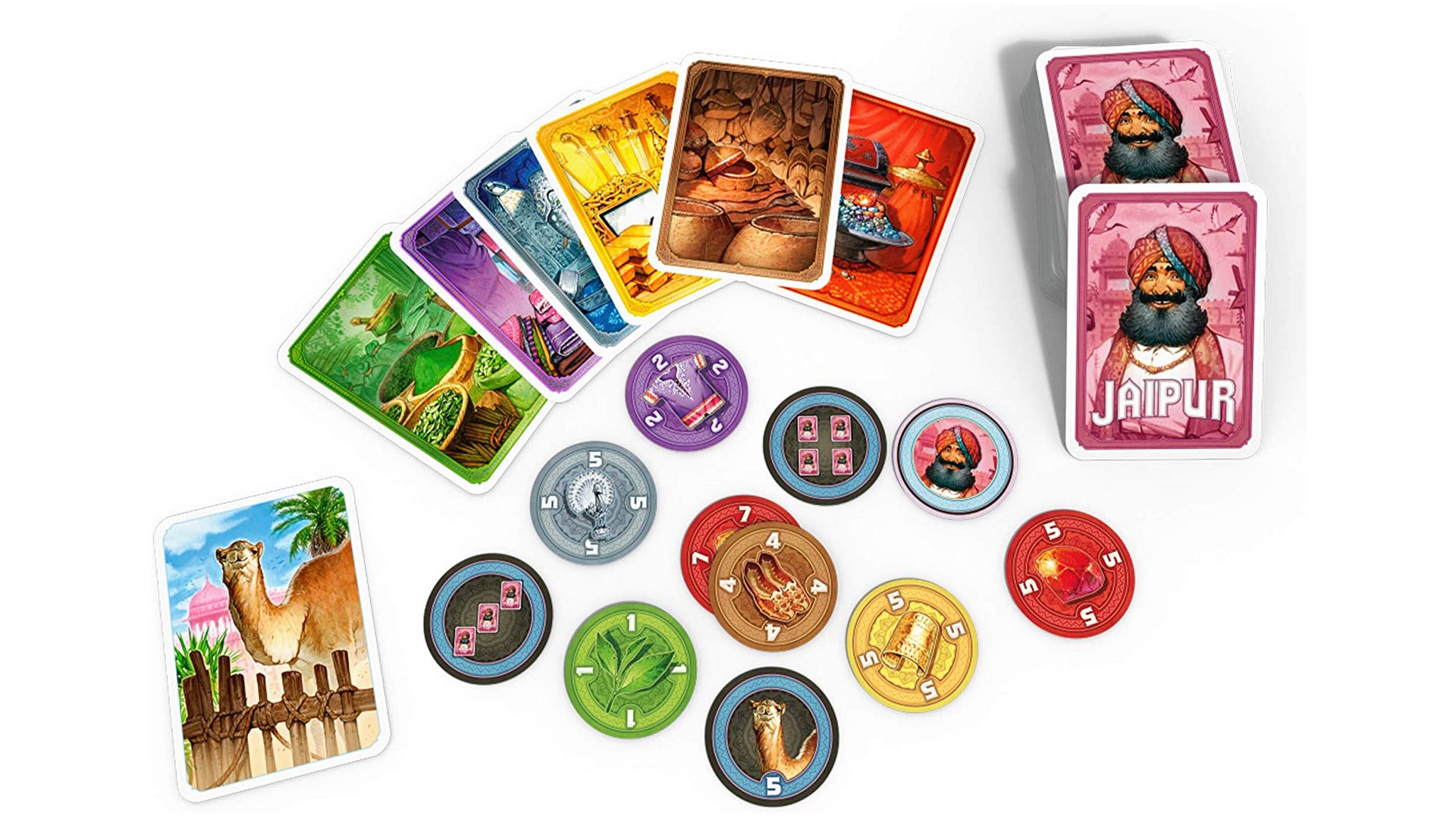
Some card types in Jaipur will be rarer than others, making them worth more than others.
There are plenty of two-player card games out there, but Jaipur stands out as one of the greatest. A game about trading, Jaipur encourages its players to indulge in their more competitive sides, stealing victory from right under their opponent’s nose. As rival merchants working for the maharaja, the players are attempting to impress by pulling off some of the sweetest deals they can. Each round has players purchasing various goods from the market, before selling them off in bulk afterwards. The more they’re able to sell at once, the more points they’ll earn. However, players will need to move quickly if they want to stay ahead of their opponent.
On their turn, a player can choose to take a single card from the market or exchange any number of cards from their hand for the same number of cards from the market. The cards they take must be of the same type, which certainly helps when players are trying to collect as many matching cards as possible. Once players have at least three cards of the same type, they can sell them to acquire the same amount of matching point tokens. The higher value point tokens of each type are kept at the top of the stack, meaning that players who sell earlier gain more points.
On the other hand, holding out for more cards to sell at once grants players a bonus token that will be worth a random amount of points, with the more valuable tokens going to the larger sales. There are only a set number of each type of card, with rarer cards providing more valuable tokens, meaning that players can end up fighting over certain types and it can get nasty. Nothing is more devastating than seeing a card of the type you’re collecting being taken by your opponent. Luckily enough, Jaipur is fast moving game that will fire you up enough to want you to play again right away.
Buy Jaipur on Amazon UK and Amazon US
2. Twilight Struggle
This two-player board game classic heats the Cold War into a tense head-to-head showdown
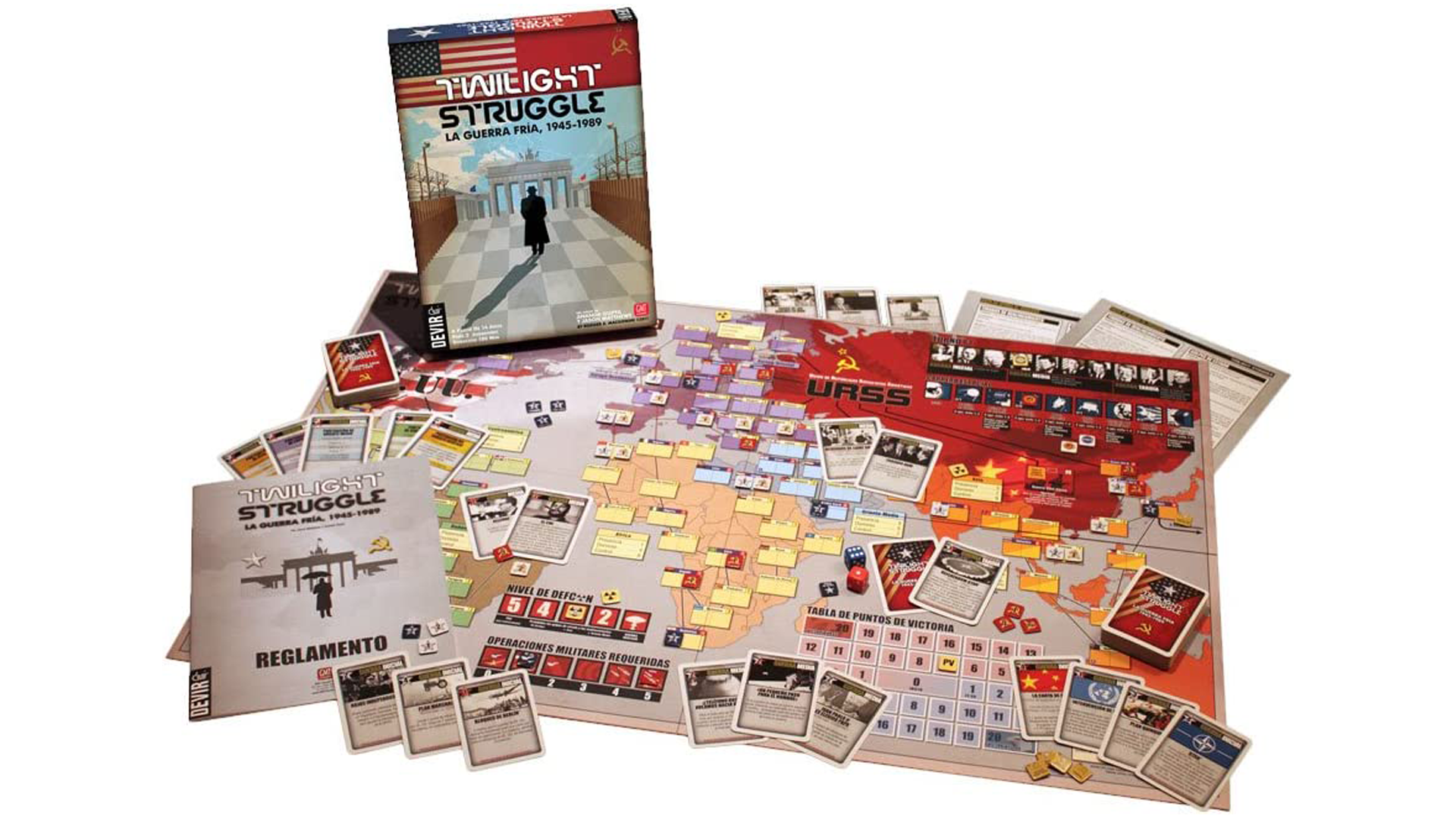
Players use various cards to grow their nation’s influence and control.
Twilight Struggle is a true modern classic, and a two-player board game that everyone should play at least once. Set during the Cold War, the historical board game puts its two players in control of the United States and Soviet Union as they engage in a frosty battle of influence, intrigue and indirect warfare across the globe.
At the centre of the game are cards that each player must play to grow their control and influence in countries around the world. These cards are based on real-life events – such as the Arab-Israeli War, Space Race and Cuban Missile Crisis – and see the US and USSR’s presence in each region affected by their and their opponent’s actions. The game loosely follows the decades from the end of World War II up to the ‘official’ end of the Cold War in 1989, with players gaining access to more events and cards as the years roll on.
As you’d expect from a simulation of one of the world’s most complicated political eras, Twilight Struggle has plenty of complexity at its heart. But the simple ‘play a card, do what it says’ surface makes it a far more approachable game than you might assume, with its complexity largely found in the decisions and strategies available to players. The two players must push their nation’s ideology and control while suppressing the influence of their opponent and avoiding all-out nuclear war.
Almost two decades after it first hit tables, Twilight Struggle remains one of the richest two-player board game experiences you can have. It is a tense, strategic head-to-head recreation of history in a surprisingly accessible package. It’s a modern classic for a reason!
Buy Twilight Struggle from Amazon UK and Amazon US.
3. Patchwork
An incredibly wholesome and fun little game about quilting
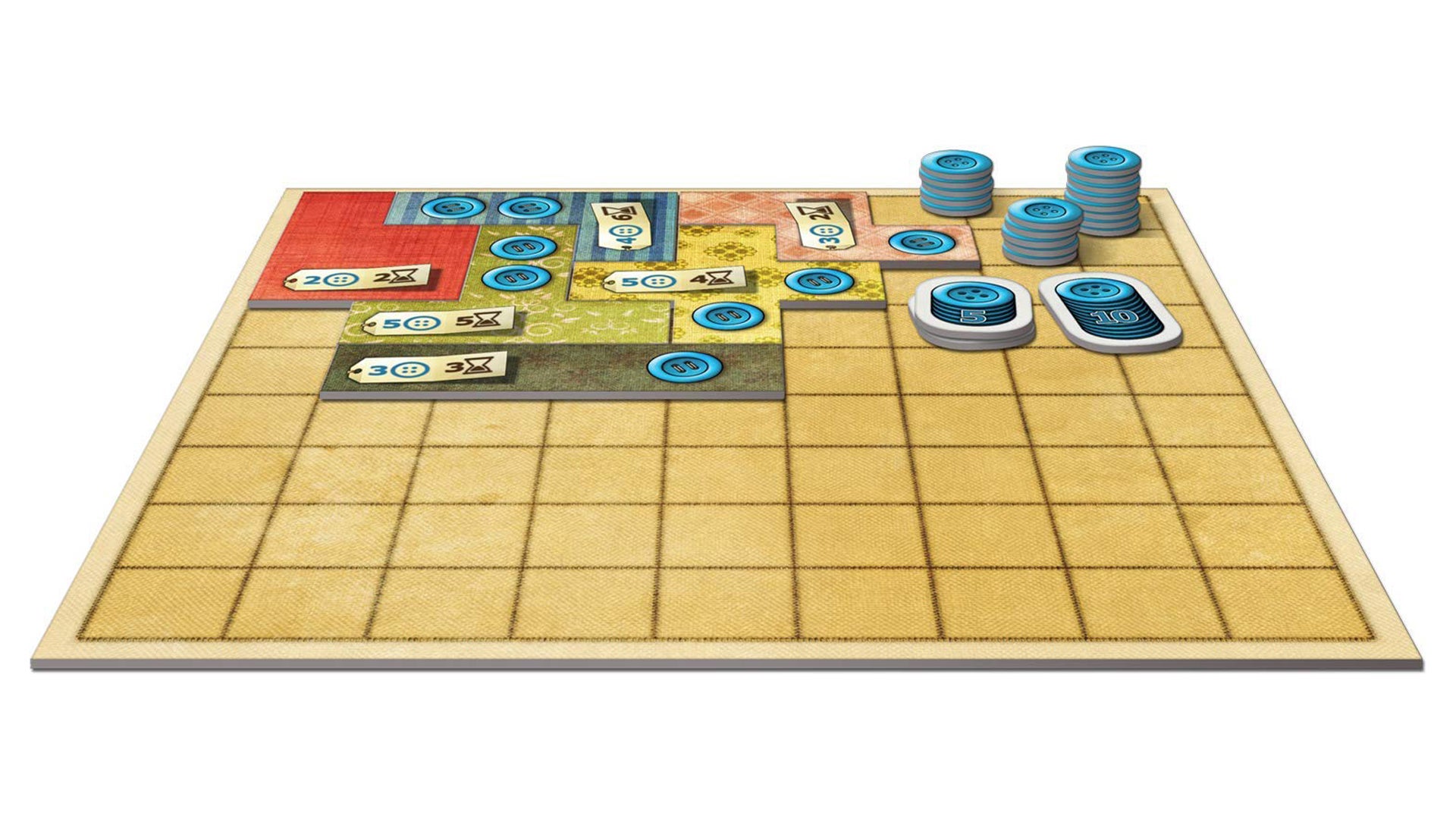
Covering your board will reduce the amount of points taken from your final score.
When it’s raining outside and all you want to do is curl up inside, all cozy-like, there’s nothing better than an intimate board gaming session. Days like this call for Patchwork, a board game for two players that’s about as charming as a corgi wearing a very small hat. Using the various trimmings you’ve acquired over the years, you must piece together a quilt – making sure to utilise as much space as possible and, obviously, scoring as many points as you can.
Each player gets their very own board, with the various quilt pieces being laid out in a circle, with each piece needing to be placed next to each other in a direct line so that they form an orderly queue. This is your selection of fabrics, with the pieces greatly varying in size and shape. Covering as much of your board as possible is important, as you’ll be punished for every empty square at the end of the game. On their turn, a player can obtain a quilt piece. If players do not have any buttons to buy a quilt piece or don’t want to buy anything, then they can choose to move their player token along the turn track to gain buttons equal to the number of spaces they move.
Another way of gaining buttons in Patchwork is to place quilt pieces displaying buttons onto your player board. Anytime a player token passes or lands on one of these button spaces both players gain as many buttons as they have currently on their player board. You’ll eventually get into the rhythm of choosing and placing quilt pieces on your board, maximising the amount of space they cover and being sure to pick some with buttons on. For a challenging and yet undeniably relaxing two-player board game, why not get wrapped up in a little Patchwork?
Buy Patchwork on Amazon UK and Amazon US
4. Klask
Air hockey plus magnets equals this fast-paced two-player game
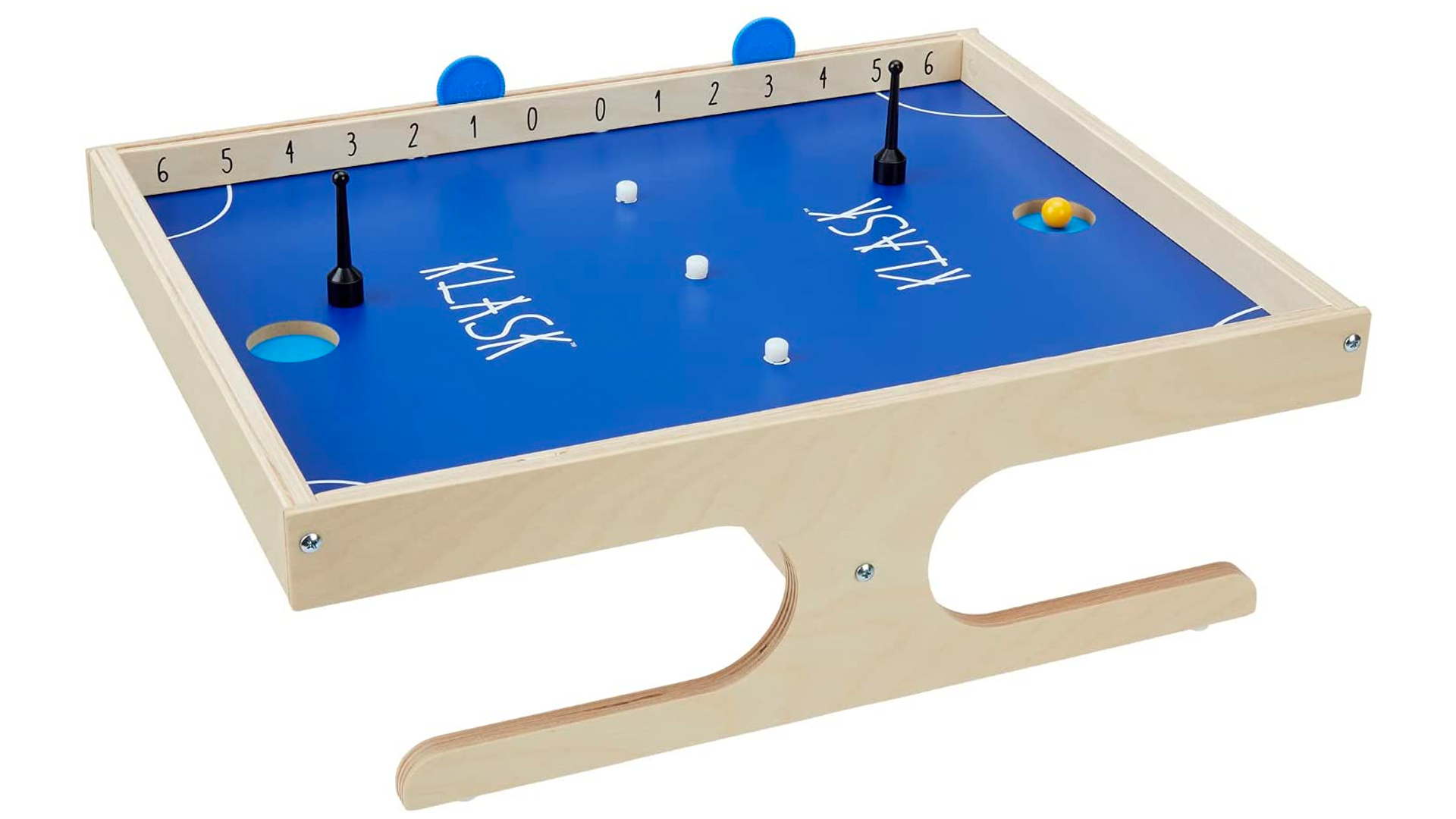
The Klask table is far more portable than you’d expect.
Created by Danish carpenter Mikkel Bertelsen one hungover morning, Klask is fittingly the perfect two-player game to enjoy over a couple of cold ones with friends.
The modern offspring of pub fixtures such as air hockey and table football, but with the addition of magnets, Klask – a Danish word for “smack!” – is a crowdpleasing head-to-head competition that plays out in a self-contained miniature wooden pitch.
Each player controls an air hockey-like pusher to knock a ball around the pitch – except, rather than moving the plastic pieces directly with their hands, they control them from underneath the board using a strong magnet.
This magnet amps up the tension of getting one over on your opponent, as players must stop the ball from going in their goal – a circular pit in the board – but also avoid getting their own magnetic piece stuck in the hole, often accompanied by the game’s signature “SMACK!”
Further obstacles come in the form of small white magnets that lie along the pitch’s halfway line, which will stick to a player’s magnet if it wanders too close – or can even be propelled towards your rival with a careful shot. Falling into your own hole or getting two of the magnets stuck to you also concedes a point, so it’s not all about shooting for goal.
Klask’s simple rules and intense, lightning-fast gameplay make it an outstanding two-player board game, but it’s the kind of game that naturally gathers a crowd and makes for fun mini-tournaments – so keeping it to just two players may be a difficult task! The original game for two players has since expanded into a four-player version, but we’d argue that the original two-player is still the best way to experience this utterly unique gem.
Buy Klask on Amazon UK and klaskyourway.com
5. Agricola: All Creatures Big and Small
A two-player version of the classic farming board game
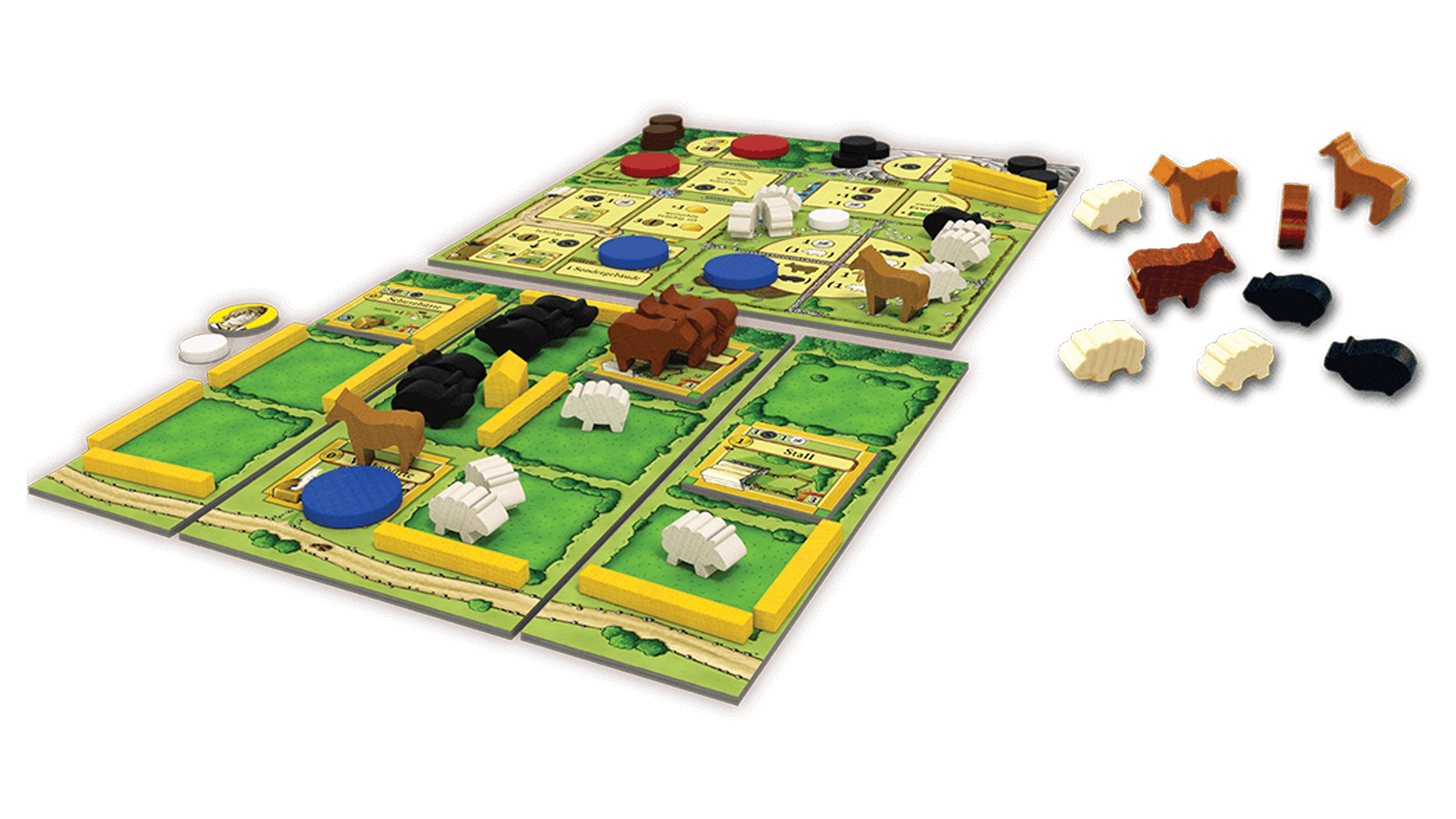
Building enclosures for your various animals is essential to winning Agricola: All Creaturs Big and Small.
Agricola is one of those enormous board games that takes a good long while to play and requires quite a number of players. Which is why it’s so good to see a two-player board game version that cuts out a lot of the fat and chooses to focus on the most important aspect of Agricola: the animals. Agricola: All Creatures Big and Small – a title that’s easy to confuse with the 1970s British television series, All Creatures Great and Small – is a tabletop title about gathering a menagerie of various farm animals, such as cows and sheep, and doing your best to find enough space for them all.
Both players start the game with a three-by-two board in which to keep their animals. This might not seem like a lot of space to begin with, and it’s not, but players will eventually be able to expand their available land as they progress. Expansion first requires victory points, which are earned by players having their newly acquired animals breed with one another to – you guessed it – create yet more livestock. It’s not just about quantity, as players will be rewarded by collecting a wider variety of farm animals as well. Ultimately, players want to be able to enclose their livestock within enclosures using their available fencing, making for a much more organised farm than one where the animals are all just roaming around and doing whatever they want.
Victory points can also be gained by acquiring certain special buildings – which require space to be built, meaning that players will have to sacrifice space that could otherwise be used to house more livestock – some of which will provide players with certain unique abilities. Not only is the theme of Agricola: All Creatures Big and Small undeniably charming, it’s an example of a fantastic two-player translation of another title – one that understands that less isn’t necessarily worse.
Buy Agricola: All Creatures Big and Small on Amazon UK and Amazon US
6. Sobek: 2 Players
Buy low and sell high in this tense set-collection board game
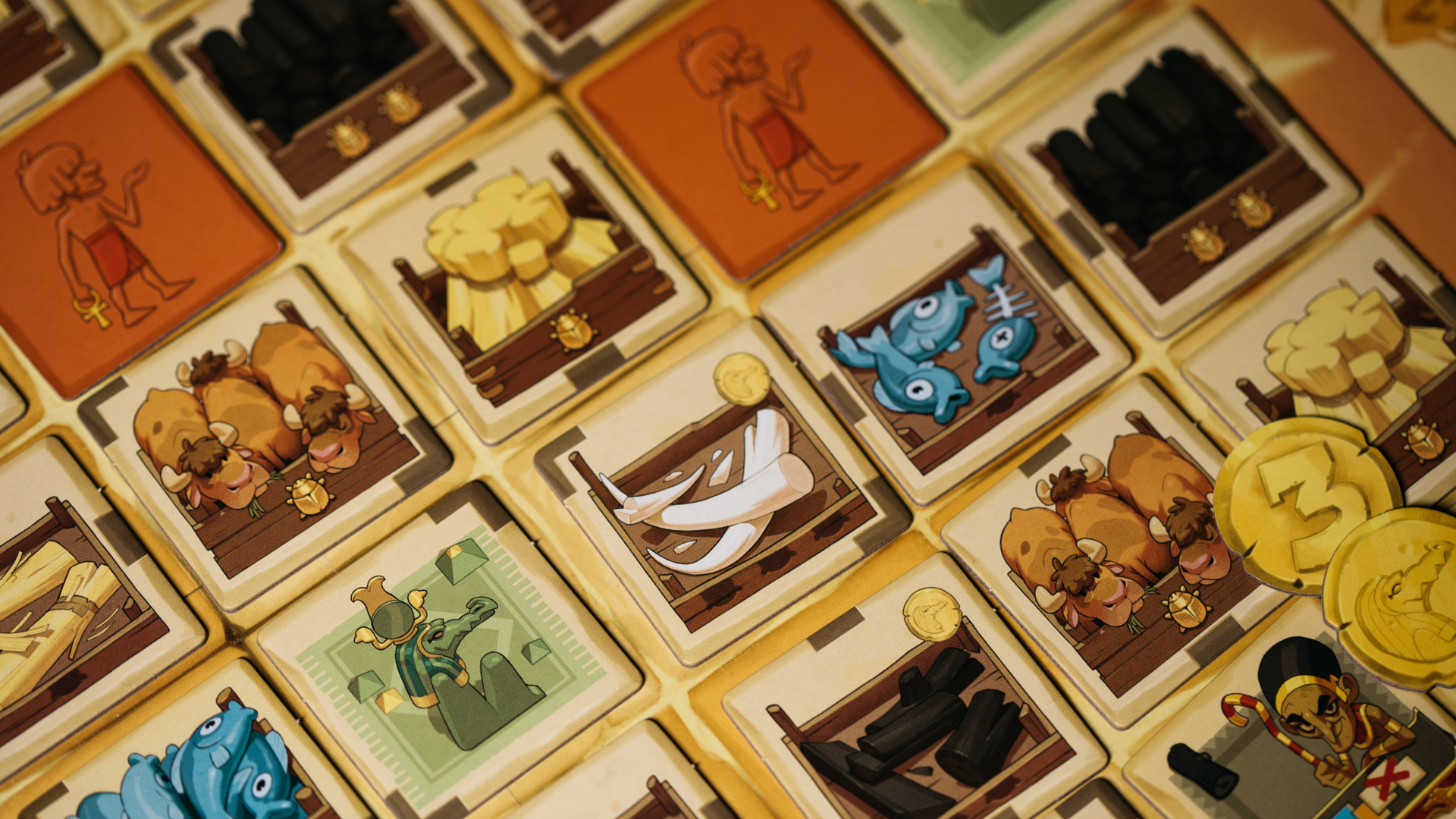
Whichever direction the golden ankh points decides which tiles players can choose from.
The original Sobek supported up to four players but its recent remake has made the bold decision to reduce the player-count to just two. Though this move does exclude larger groups from playing, it was most definitely the right one when it comes to making the most of Sobek’s gameplay. Sobek: 2 Players takes the basic premise of the 2010 original – gathering and trading in items to make the most wealth possible – and turns it into a tense two-player standoff in which only the meanest thrive.
As merchants looking to make a fortune in the markets of ancient Egypt, players will need to collect matching tiles before selling them off in the largest bundle they can gather. Besides the number of tiles, players will also be looking to collect tiles which have the highest number of scarab beetles on them – as these will net them more gold than others. In order to gain tiles, players will take turns to choose one tile from a shared grid. Which tile they can take will depend on what direction the golden ankh is pointing in, with players restricted to take a tile from the line designated by the ankh. However, for every tile between the ankh and the chosen tile, players will need to take an amount of corruption: which turns into minus points at the end of the game.
This means that taking a tile you really want may require a sacrifice of taking corruption – but it could be worth it for all the points you’ll gain. Players can also take tiles to deliberately set the ankh up for future turn, whether to benefit them or punish their opponent. There are also ways to move or change the direction of the ankh without having to take a tile, thereby enabling even more opportunities to be crafty. Sobek: 2 Players is a perfect example of how an older, less-remembered game can be transformed into a really special two-player experience.
Buy Sobek: 2 Players from Zatu UK and Amazon US.
7. Summoner Wars: Second Edition
Go head-to-head with a friend in this mix of Magic: The Gathering and XCOM
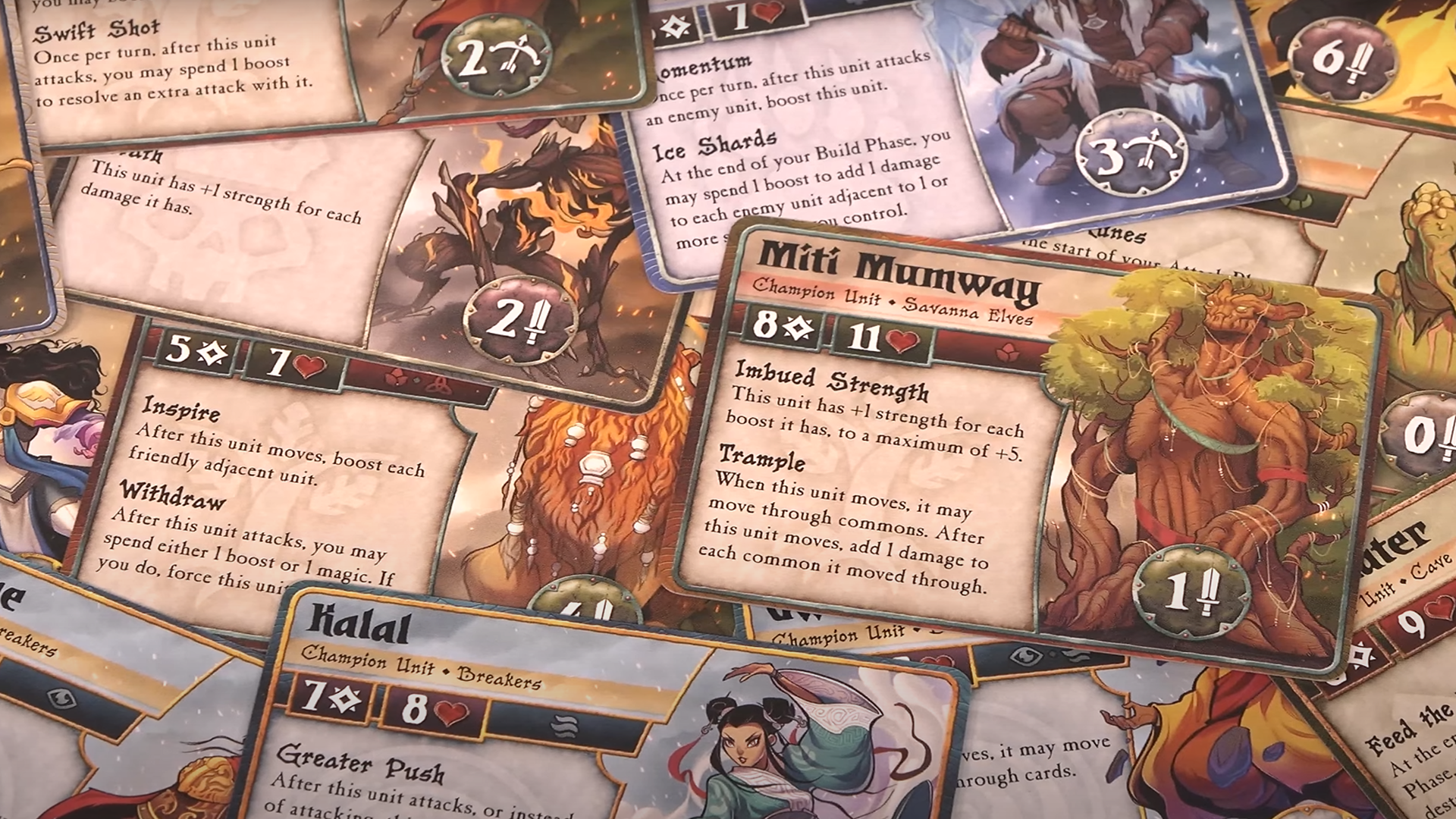
Every faction will require players to approach this two-player board game in a different way.
The original Summoner Wars helped catapult board game publisher Plaid Hat to fame back in 2009, so it seems only right that its full-blown second edition has helped the studio relaunch as a newly re-independent creator over a decade later following its separation from Asmodee in 2020.
For the unfamiliar, Summoner Wars is an expandable card game that plays like a mixture of classic two-player card games such as Magic: The Gathering and the tactical strategy of video games like Fire Emblem, Final Fantasy Tactics and XCOM.
Like Magic, players spent mana points to summon creatures from their unique deck onto the battlefield, looking to whittle down the health of their opponent’s rival summoner to zero.
What makes Summoner Wars different to your typical card-battler is the introduction of a gridded board, onto which the cards are placed and moved around like units in a turn-based strategy game. As well as creatures, players can build new structures – including summoning gates and defences – to increase the range and power of their creatures’ attacks or block their opponent’s abilities.
Each of Summoner Wars’ factions has a unique play style, with new factions introduced to the six found in its starter set through fixed expansions – meaning no need to buy randomised booster packs. Although the decks can be played as-is, players can also customise their loadout for a new strategy and play style from game to game.
Summoner Wars is a fantastic two-player board game for fans of classic competitive card games and tactical video games, and its second edition improves on the original’s already excellent gameplay with a number of quality of life additions that streamline and tighten up rules rather than making sweeping changes. The new edition also saw the introduction of a full digital version of Summoner Wars, letting newcomers and existing fans play online for a fairly small monthly subscription. You can even try out the game for free, so there’s no excuse to let this terrific two-player board game pass you by.
Buy Summoner Wars: Second Edition on Amazon UK and Amazon US
8. 7 Wonders Duel
The beloved civ-building card game for two players
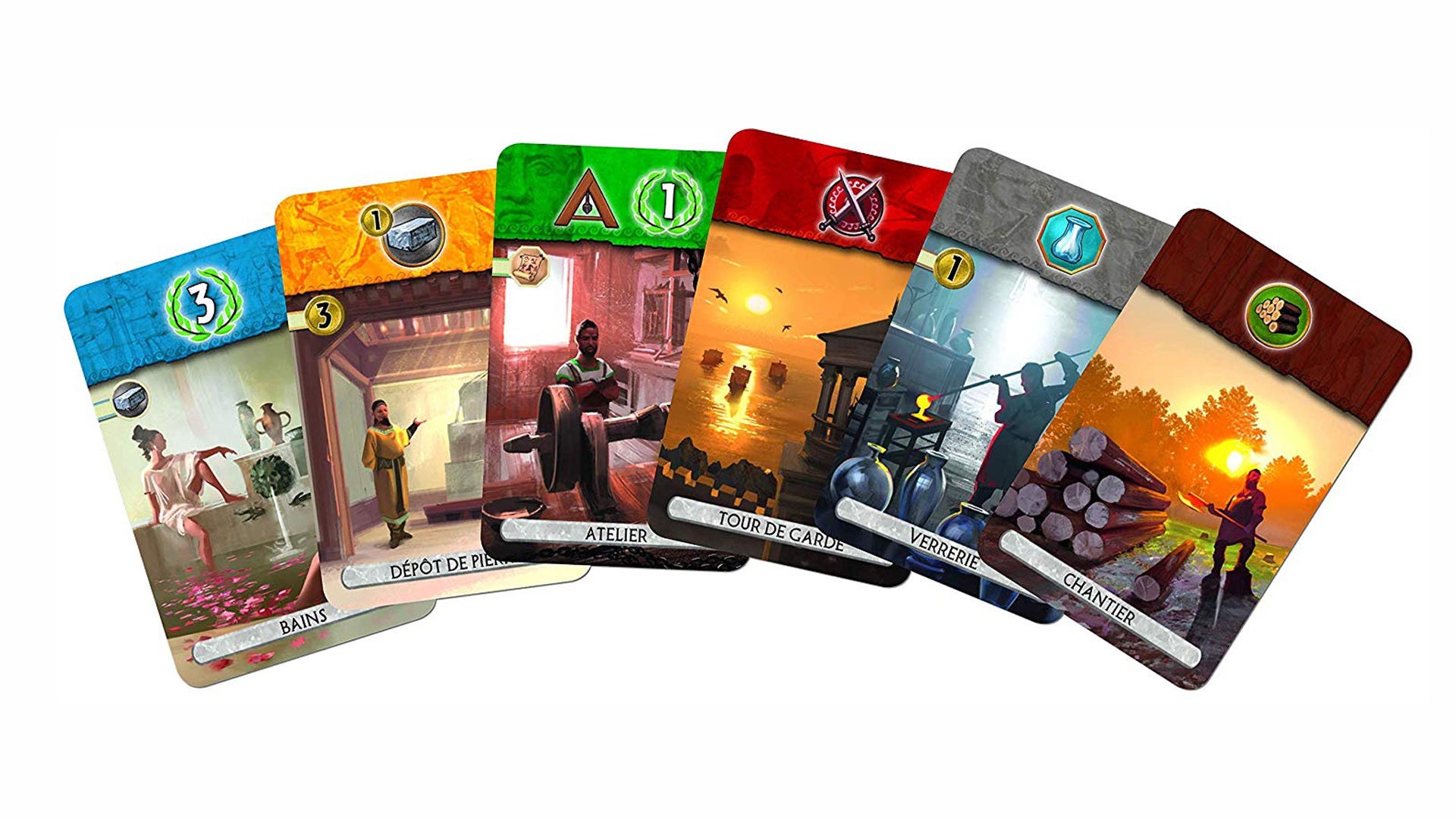
Each type of card will provide a different benefit to those players who take them.
The original 7 Wonders is considered by many one of the best board games of all time. Taking the epic theme of leading a civilisation through the ages but playing out in well under an hour, 7 Wonders found the perfect balance between the deep strategy of developing your technology, culture, science and more, and the simplicity of only having to pick a single card and do what it says each turn.
7 Wonders Duel takes 7 Wonders and pares it down even further, making it a board game for two players only. (7 Wonders technically has rules for two players, but they’re not the best way to play if there’s just two of you.)
Rather than passing cards around the table, in 7 Wonders Duel the two players pick from the middle of the table, having to choose from cards that have been uncovered in earlier turns. As they gather precious resources, the players can even build wonders – yes, like those Wonders – that help their civ grow further.
The thrust of the two-player board game remains largely the same, as the players race to develop their civilisation faster than their opponent – looking to claim victory through scientific breakthroughs, military might or overall advancement. 7 Wonders Duel plays just as fast – if not faster – than its bigger sibling, making it the perfect two-player game to break out with a friend or partner.
7 Wonders was a brilliant board game, and 7 Wonders Duel easily lives up to its legacy as one of the best board games for two people. It’s a whirlwind trip through history in a small, quick card game that’s easy to learn and fun time after time to play. One of the wonders of the board game world? Maybe…
Buy 7 Wonders Duel on Amazon UK and Amazon US
9. Lost Cities
Explore ancient ruins in the hopes of uncovering amazing discoveries
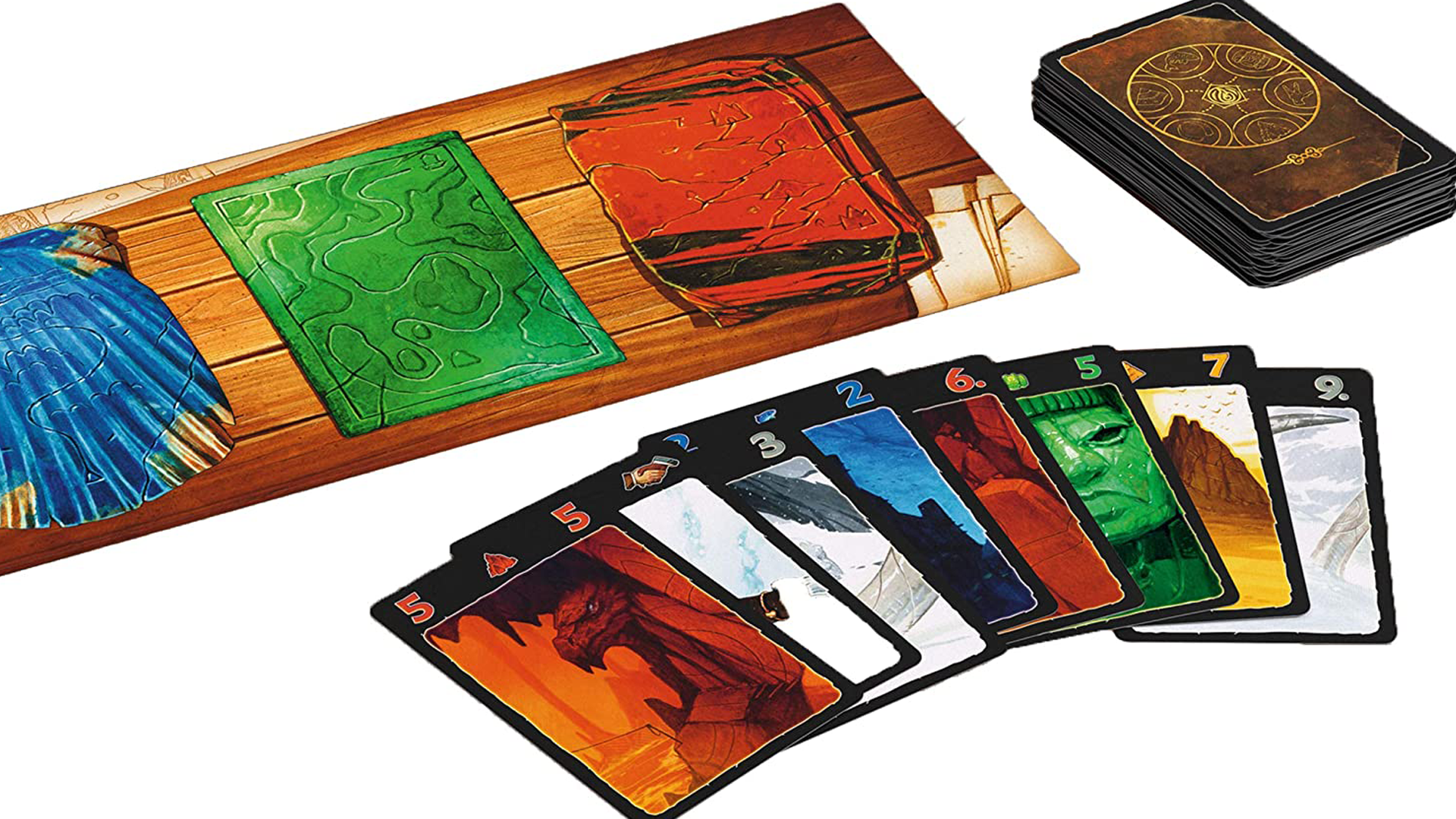
Deciding to go on an expedition is not a decision to be taken lightly.
Lost Cities is considered an absolute classic and one of legendary designer Reiner Knizia’s best. As rival archeologists, both players in Lost Cities plan and embark on expeditions at the same time, substantially increasing the stakes. The reputations, and potentially even careers, of each archaeologist are on the line, with the goal of successful exploration in their sights. These expeditions are represented by columns of numbered cards which players will need to lay down in numerical order. However, players don’t necessarily need to play cards consecutively, just higher-numbered cards on top of lower-numbered ones. But the more cards played onto an expedition the better, as they’ll gain players a greater number of points at the end of the game.
Choosing to begin an expedition is not a decision to be made lightly, as you’ll be scored on all your columns, regardless of how many cards you’ve placed there. Travelling around the world with an entire team costs a lot of money, which is why the score for every expedition you start begins at minus-20 points. This means that players need to place cards of a total value of at least 20 in order to not score minus points. What’s more is that playing special handshake cards onto an expedition will multiply its score total, which also applies to minus totals. This means you’ll have to be sure you’re going to be able to lay down enough cards on an expedition to avoid that minus point penalty.
This is what makes Lost Cities so exciting and intense. Players share the same deck of cards, meaning that they both draw from the same pile. You’ll spend most of the game praying that you’ll draw the cards you need to pass that minus-20 total, otherwise you’ll quickly regret your past decisions as you watch your expeditions drain your points. For a game of high risk and high reward, crack open a copy of Lost Cities.
Buy Lost Cities on Amazon UK and Amazon US
10. Air, Land & Sea
A tight, tactical, two-player battle for supremacy
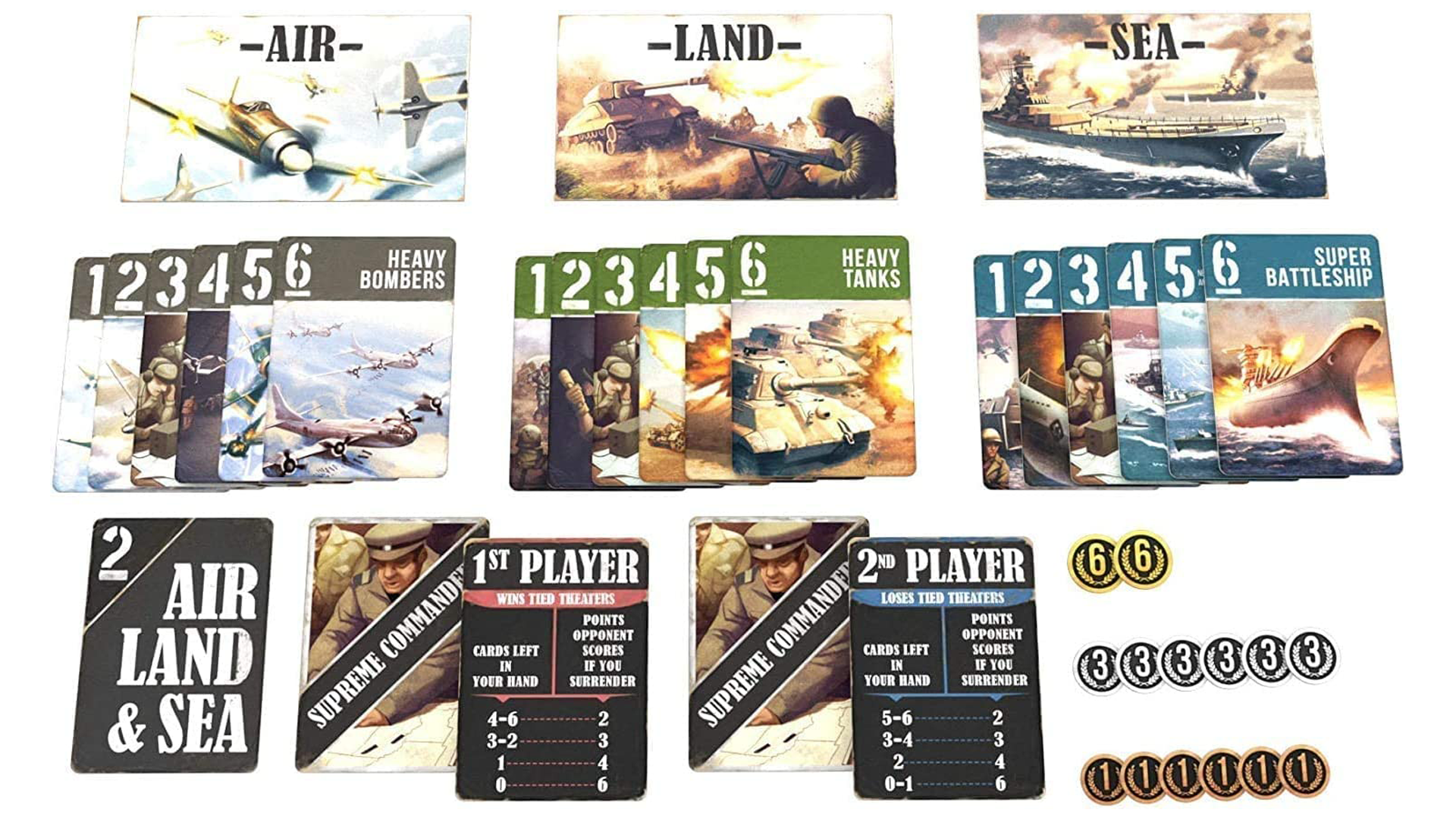
Players battle it out over several different theatres of war.
Air, Land & Sea packs a whole lot of game into a very small box. The game comprises little more than a deck of cards, with its two players only having six cards in their hand during each round. They must play these cards carefully to three different theatres of war – air, land and sea, you’ll be surprised to hear – to gain overall domination of the battlefield.
Air, Land & Sea only takes a couple of minutes to learn its basic rules. On your turn, you can play a card face-up in its matching theatre for its strength value and any abilities, or facedown in any of the theatres as a wild card worth 2 strength. There’s also the option to withdraw – with it sometimes being more worthwhile to sacrifice a battle early to avoid your opponent scoring more points at the end of the round. When a player withdraws or all 12 cards have been played, the player who holds the most theatres – with the highest total in each – scores points. 12 points, and victory is yours.
The rules may be easy to pick up, but the intense wrestle over the battlefields using your limited options make Air, Land & Sea a fiercely tactical head-to-head battle on the tabletop. Luckily, you’ll wrap up most of your fights in just 15 minutes or so, so it’s a burst of energetic competition that always begs for a rematch.
Air, Land & Sea’s simple rules, fast playtime and deeply competitive format make it a fantastic two-player board game to play in a spare 15 minutes, or take with you in your bag the next time you’re travelling with a companion. It’s perfect for fans of similarly compact games like Love Letter who are looking for a two-player option, and fans of tactical historical wargames after a lighter, faster filler.
Whoever you are, and whomever you’re playing with, Air, Land & Sea is a two-player gem that will take up a bigger space iny our heart than it does on your shelf.
Buy Air, Land & Sea from Amazon UK and Arcane Wonders.











